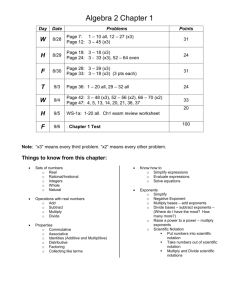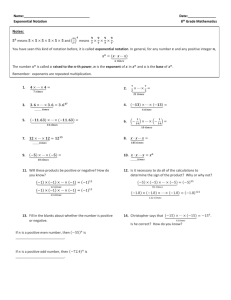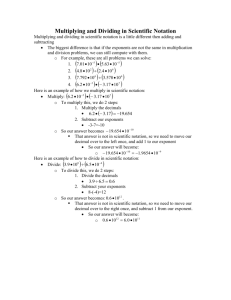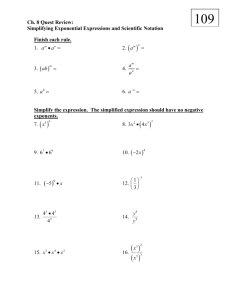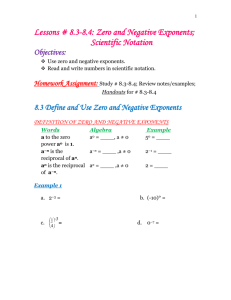Grade-8-Unit-1-Exponents
advertisement
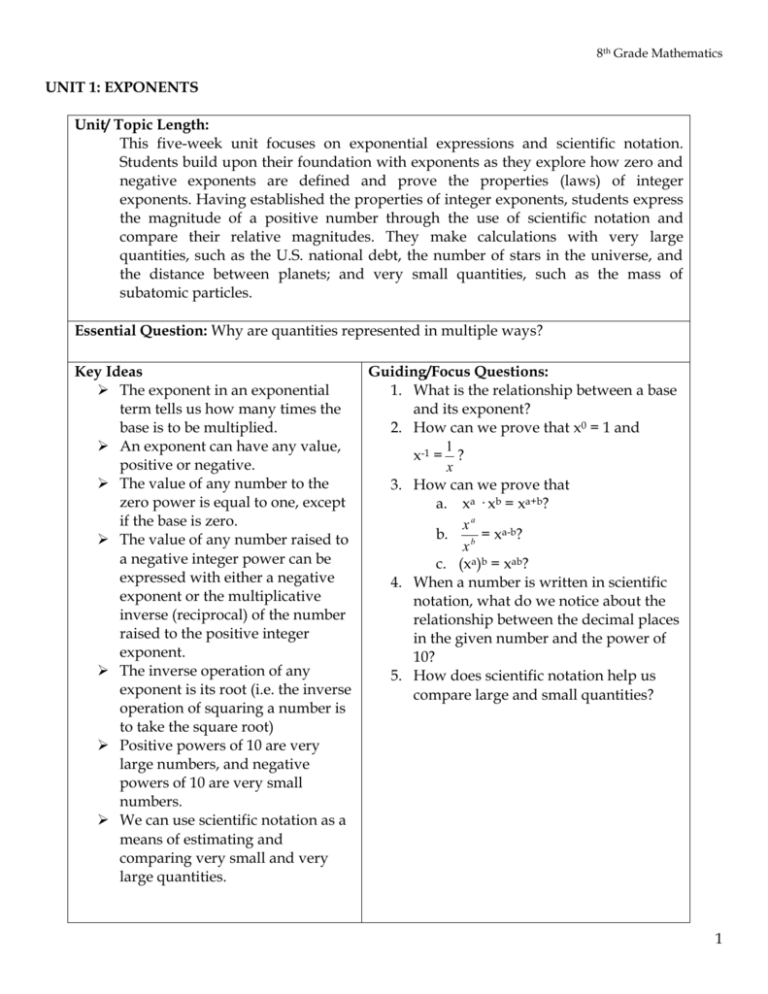
8th Grade Mathematics UNIT 1: EXPONENTS Unit/ Topic Length: This five-week unit focuses on exponential expressions and scientific notation. Students build upon their foundation with exponents as they explore how zero and negative exponents are defined and prove the properties (laws) of integer exponents. Having established the properties of integer exponents, students express the magnitude of a positive number through the use of scientific notation and compare their relative magnitudes. They make calculations with very large quantities, such as the U.S. national debt, the number of stars in the universe, and the distance between planets; and very small quantities, such as the mass of subatomic particles. Essential Question: Why are quantities represented in multiple ways? Key Ideas The exponent in an exponential term tells us how many times the base is to be multiplied. An exponent can have any value, positive or negative. The value of any number to the zero power is equal to one, except if the base is zero. The value of any number raised to a negative integer power can be expressed with either a negative exponent or the multiplicative inverse (reciprocal) of the number raised to the positive integer exponent. The inverse operation of any exponent is its root (i.e. the inverse operation of squaring a number is to take the square root) Positive powers of 10 are very large numbers, and negative powers of 10 are very small numbers. We can use scientific notation as a means of estimating and comparing very small and very large quantities. Guiding/Focus Questions: 1. What is the relationship between a base and its exponent? 2. How can we prove that x0 = 1 and 1 x-1 = ? x 3. How can we prove that a. xa · xb = xa+b? xa b. = xa-b? xb c. (xa)b = xab? 4. When a number is written in scientific notation, what do we notice about the relationship between the decimal places in the given number and the power of 10? 5. How does scientific notation help us compare large and small quantities? 1 8th Grade Mathematics NYS Common Core Standards for Mathematics Assessed: Mathematical Content 8.EE.1 Know and apply the properties of integer exponents to generate equivalent numerical expressions. For example, 32 × 3–5 = 3–3 = 1/33 = 1/27. 8.EE.3 Use numbers expressed in the form of a single digit times an integer power of 10 to estimate very large or very small quantities, and to express how many times as much one is than the other. For example, estimate the population of the United States as 3 × 108 and the population of the world as 7 × 109, and determine that the world population is more than 20 times larger. 8.EE.4 Perform operations with numbers expressed in scientific notation, including problems where both decimal and scientific notation are used. Use scientific notation and choose units of appropriate size for measurements of very large or very small quantities (e.g., use millimeters per year for seafloor spreading). Interpret scientific notation that has been generated by technology. Mathematical Practices 2. Reason abstractly and quantitatively. 3. Construct viable arguments and critique the reasoning of others. 6. Attend to precision. 7. Look for and make use of structure. 8. Look for and express regularity in repeated reasoning. Content Exponential Notation Numbers Raised to the Zeroth Power Negative Exponents Laws of Exponents Scientific Notation Operations with Scientific Notation Skills Simplify expressions with integer exponents Write equivalent numerical and symbolic expressions using the laws of exponents Express large and small numbers in scientific notation Estimate and compare numbers written in scientific notation Add, subtract, multiply, and divide numbers written in scientific notation Determine appropriate units for various measurements Vocabulary/ Key Terms 2 8th Grade Mathematics base, exponent, power, whole number, integer, scientific notation ASSESSMENT EVIDENCE Initial Assessment Unit Readiness Test Formative Assessments: Quizzes Exit Slips Checks for Understanding Short- and Extended-Response questions used throughout the unit. Reflections Formative Assessment Tasks Summative Assessments: 1. Unit test 2. Performance Tasks Properties of Exponents Scientific Notation TEACHING PLAN Teaching and Learning Activities: 1. Administer the Unit Readiness Test. Students who demonstrate weakness in evaluating numerical and exponential expressions will be given remediation. 2. Instruction follows the Launch-Explore-Summarize flow. 3. Use the guiding/focus questions to focus each lesson. Lesson 1: Simplifying Exponential Expressions (4 days) Calculate values of exponential expressions with integer exponents Lesson 2: Product Laws of Exponents (2 days) Multiplying Expressions with the Same Base Multiplying Expressions with the Same Exponents Lesson 3: Quotient Laws of Exponents (2 days) Dividing Expressions with the Same Base Dividing Expressions with the Same Exponents Lesson 4: Power to a Power Law (2 days) Raise a power to a power [e.g. (23)4] 4. Administer Performance Task 1 Lesson 5: Writing Numbers in Scientific Notation (4 days) Use numbers expressed in scientific notation to estimate very large or 3 8th Grade Mathematics very small quantities, and to express how many times as much one is than the other. Lesson 6: Adding and Subtracting with Scientific Notation (3days) Perform addition and subtraction with numbers expressed in scientific notation, including problems where both decimal and scientific notation are used. Lesson 7: Multiplying and Dividing with Scientific Notation (3 days) Perform multiplication and division with numbers expressed in scientific notation, including problems where both decimal and scientific notation are used. 5. Administer Performance Task 2 6. Use the essential question as a post-assessment. 7. Administer the unit test. Resources: Connected Math Project 3 (CMP3) Unit: Growing, Growing, Growing: Exponential Functions (Investigation 5) NYS Common Core Math Module 1: Integer Exponents and Scientific Notation Impact Mathematics Course 3 Integrated Algebra Textbook MathXL (Pearson’s online homework, tutorial, and assessment system) Scientific Calculators CALENDAR Time Spent on Standard 15 days Standards 8.EE.1 Topics To Cover CMP3 Unit: Growing, Growing, Growing (Investigation 5) Overview of the unit Exponents o Zero o Negative Evaluating Exponential Expressions Properties/Laws of Exponents 4 8th Grade Mathematics 10 days 8.EE.3 8.EE.4. Scientific notation Operations with scientific notation 5

